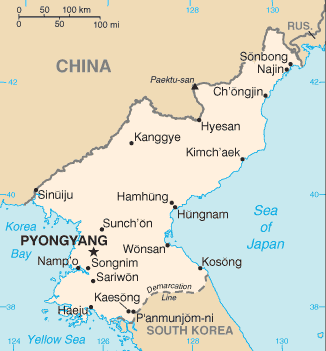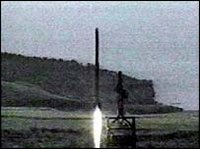Believed Too Heavy To Fit On Missile... For Now
Confirming the worst fears of most of the civilized world, North
Korea has tested its first nuclear device underground... setting
off about a four on the Richter scale, and about a thousand on the
world crisis meter.

Its ambassador to the United Nations said North Korea should be
congratulated on this achievement, rather than condemned. President
Bush called the test a "provocative act", China denounced it as
"brazen", and the Japanese Prime Minister labeled it a "grave
threat to our nation."
Of course, as long as the rogue nation blows up dirt under its
own surface, there isn't much of a threat. It is the delivery to
another country of the nuke that has so many nations concerned.
North Korea has been struggling to perfect its larger Taepodong
- 2 missile. Though the missile failed in its maiden launch,
experts believe that it has the theoretical capability to reach the
Western US from Korea.
As ANN reported last July, a
series of seven test firings were conducted of both the smaller
Nodong missile, as well as the failed Taepodong-2.
Because this is a first generation nuclear bomb, it is very
likely a fairly large and heavy device. Analysts believe North
Korea has about enough fissile material to make about six or eight
bombs of similar size. The BBC reports that a recent analysis
from the Institute for Science and International Security said
there was little evidence to suggest North Korea was capable of
making the nuclear warhead light enough for the Taepodong-2... at
least for now.
The current device could most likely be trucked, shipped, or
even flown aboard a large transport aircraft, but those delivery
options are fairly slow... and could easily be intercepted if
their contents were known. Defense experts agree that if you want
your nuclear bomb to be most effective, it's got to
be carried aboard a supersonic missile.
Reuters says experts believe the weight of the bomb would have
to be reduced to around 1,000 to 1,500 pounds. The dimensions would
also have to be shrunk to fit in the missile's nosecone which
is around five feet high and about a yard wide.
Reuters continues that "the process of 'mating' a nuclear
warhead to a conventional missile is complex," said Lee Willett,
defense analyst at the Royal United Services Institute in
London.
 "Nuclear warheads have
a different weight -- there'll be a differenent guidance
requirement than you have with a conventional missile," he said.
"It's not just a case of getting a conventional missile and
sticking a nuke on top of it. It's a fundamentally different
weapon."
"Nuclear warheads have
a different weight -- there'll be a differenent guidance
requirement than you have with a conventional missile," he said.
"It's not just a case of getting a conventional missile and
sticking a nuke on top of it. It's a fundamentally different
weapon."
If those problems are surmounted, there's always the popular,
but short range Scud C, which would be a viable choice to hit
targets in South Korea, says Duncan Lennox, editor of Jane's
Strategic Weapons Systems.
Another reason to be concerned is the increasing cooperation
between North Korea and Iran. That Middle-East country has been
working to build its own nuclear bomb -- and it also has a
very active missile development program of its own.
Unconfirmed reports have stated that the Koreans and Iranians
are actively cooperating with each other trading missile and
nuclear technology. These same reports say that a number of Iranian
delegates and scientists were present for the North Korean missile
tests last July.
 Aero-TV: DeltaHawks Diesel Power Steps Into the Spotlight
Aero-TV: DeltaHawks Diesel Power Steps Into the Spotlight NTSB Prelim: Mooney Aircraft Corp. M20K
NTSB Prelim: Mooney Aircraft Corp. M20K ANN FAQ: Turn On Post Notifications
ANN FAQ: Turn On Post Notifications ANN's Daily Aero-Linx (12.20.25)
ANN's Daily Aero-Linx (12.20.25) Aero-News: Quote of the Day (12.20.25)
Aero-News: Quote of the Day (12.20.25)




